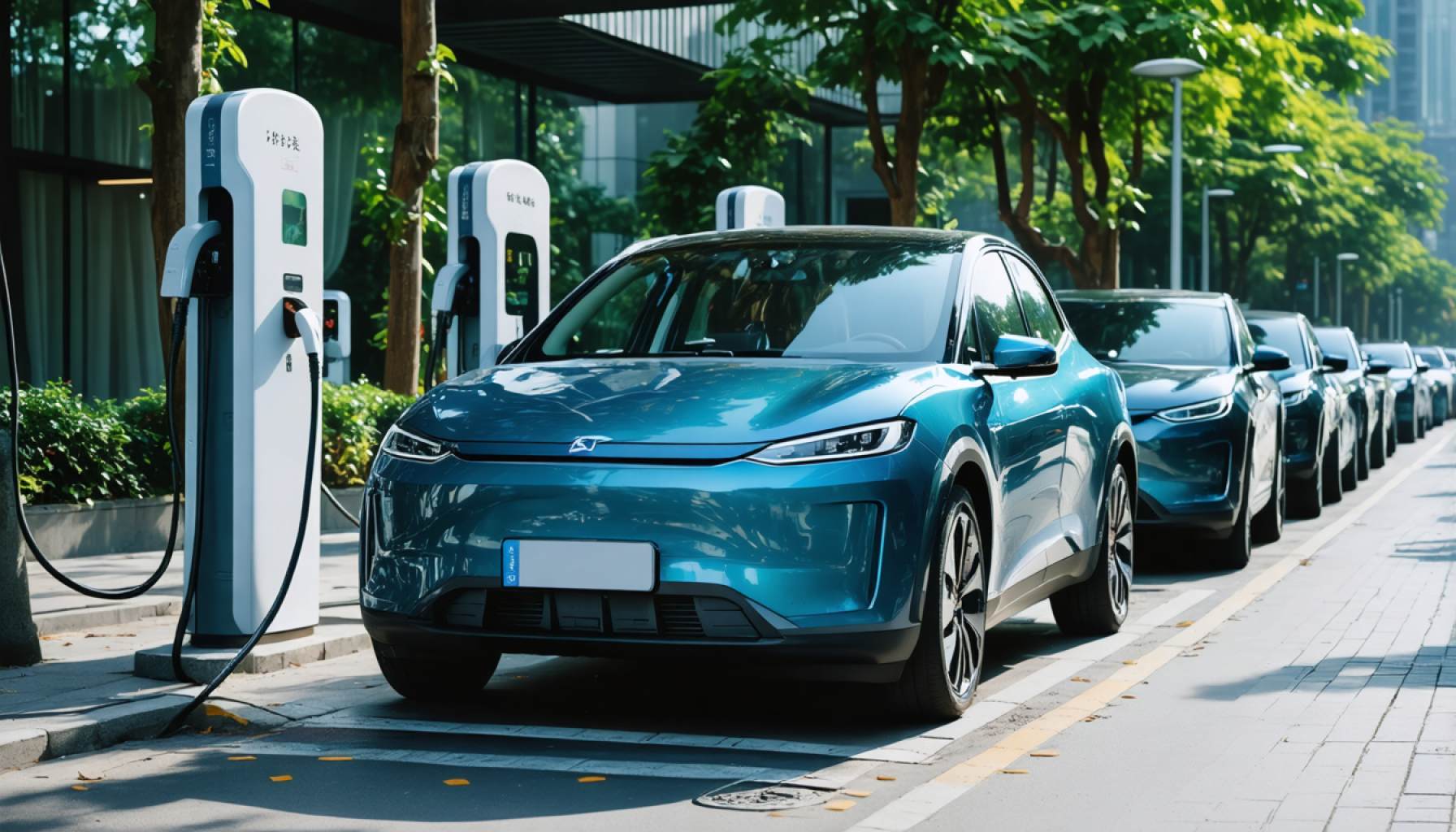- China’s EV market witnesses a race between battery swapping and ultra-fast charging, both aimed at eliminating range anxiety.
- Battery swapping allows rapid energy pack changes in just 100 seconds, offering unmatched convenience.
- Ultra-fast charging can restore 400 kilometers of range in five minutes, showcasing impressive speed.
- CATL plans to build 1,000 battery swapping stations in China, backed by significant pre-orders.
- EV giants like Nio and BYD actively compete, unveiling innovations at events like Auto Shanghai.
- Battery swapping can cut EV ownership costs by up to 40%, saving drivers substantial money.
- The EV evolutions point to a future of seamless integration into everyday life, addressing diverse needs.
- Fast-charging and battery swapping could complement each other, benefiting both consumers and manufacturers.
- The relentless drive for innovation in the EV sector supports sustainability and a cleaner, more efficient future.
The bustling landscape of China’s electric vehicle market is rapidly evolving as two pioneering technologies vie for dominance. In this thrilling sprint towards efficiency, battery swapping technology showcases a dazzling promise of speed, pitting itself against the relentless momentum of ultra-fast charging capabilities. At the heart of this electrifying race lies a singular goal: banish the pervasive range anxiety that shadows electric vehicle owners.
Like a scene from a futuristic odyssey, the battery swap stations allow drivers to roll up, swap out their depleted energy packs, and cruise away rejuvenated in just a swift 100 seconds. It’s a choreography of efficiency that seems almost magical. Yet, the fast-charging brigade counters with its own spectacle, empowering vehicles to reclaim 400 kilometers of driving range in a mere five minutes.
CATL, one of the titans of battery production, is surging ahead, setting out to establish a sprawling network of 1,000 battery swapping stations across China within the year. Ambitious? Absolutely. But their strategic calculus is underscored by securing pre-orders for an ambitious 107,500 Choco-SEB swappable batteries from myriad companies. Alongside them, electric vehicle manufacturers like Nio unveil their cutting-edge innovations at spectacles such as the Auto Shanghai trade show, battling for attention against another powerhouse, BYD.
As the world’s preeminent EV manufacturer, BYD isn’t just idling. With their Super e-Platform heralding charging powers of up to a colossal 1 megawatt, they’ve launched their latest models, the Han L and Tang L, enticing the market with promises of speed and power.
The allure of battery swapping extends beyond mere convenience; it’s a financial boon. By enabling drivers to rent rather than purchase batteries outright, this model can trim a substantial portion—up to 40%—off the overall cost of EV ownership. Imagine saving up to 50,000 yuan (around $6,876) just by opting for this smarter approach.
Amidst this technological duel, the broader implications emerge like dawn-light over a new horizon. The confluence of these innovations doesn’t only redefine convenience; it sketches the outlines of a future where electric vehicles seamlessly integrate into the pulse of everyday life, unshackling themselves from the limitations of range and time.
In this electrified arena, one truth becomes clear: the evolution of electric vehicles is not a solitary path but a multifaceted journey. Fast-charging capabilities and battery swapping will likely coalesce into a harmonious dance, addressing diverse needs and preferences. For consumers and manufacturers alike, this equates to a win in every sense.
In the end, what truly commands attention is this industry’s relentless spirit to innovate and adapt—traits that not only ensure sustainability but also promise a future that’s as enlightened as it is efficient. As China’s EV market sets the pace for the world, each technological stride fuels the promise of a cleaner, faster tomorrow.
Will Battery Swapping or Ultra-Fast Charging Dominate China’s EV Market?
The Race for Dominance: Battery Swapping vs. Ultra-Fast Charging
China’s electric vehicle (EV) market serves as a fascinating battleground for two pioneering technologies: battery swapping and ultra-fast charging. Each technology presents a unique solution to the persistent challenge of “range anxiety” among EV owners.
Battery Swapping: A Game-Changer
Battery swapping offers a futuristic approach, allowing drivers to replace depleted batteries within as little as 100 seconds. Companies like CATL are spearheading this technology, planning to install 1,000 battery swapping stations across China within a year. This is backed by substantial demand, reflected in pre-orders for 107,500 Choco-SEB swappable batteries from various companies.
Benefits of battery swapping include:
– Cost Savings: By allowing drivers to rent batteries, this model can reduce the initial purchase cost of an EV significantly, even by up to $6,876.
– Convenience: Quick swaps eliminate the wait time associated with charging, adding significant appeal to urban drivers with busy schedules.
Ultra-Fast Charging: The Speed King
On the other hand, ultra-fast charging technology is not far behind in its promise of efficiency. Companies like BYD are leading the charge with platforms capable of delivering up to 1 megawatt, restoring 400 kilometers of driving range within five minutes. This technology appeals to those who prefer the convenience of traditional refueling stations without requiring multiple stops or extensive infrastructure changes.
Emerging Industry Trends and Market Forecasts
With China leading the EV race, these technologies are shaping future trends:
– Infrastructure Development: More investments in charging infrastructure are expected to meet their technological commitments.
– Consumer Adaptation: As EV adoption rises, the choice between swappable and fast-charging stations will likely hinge on specific regional needs and consumer preferences.
According to industry experts, the Chinese EV market could set standards globally, potentially creating a ripple effect for infrastructure development across other nations.
Pros and Cons Overview
Battery Swapping:
– Pros:
– Rapid energy replacement
– Lower initial costs for EV owners
– Environmentally friendly by promoting battery recycling
– Cons:
– Requires standardized battery sizes
– Infrastructure expansion costs and logistic complexities
Ultra-Fast Charging:
– Pros:
– Maintains the traditional gas station model
– Less disruption to vehicle design at the manufacturing level
– Cons:
– High energy demand might strain the grid
– Short lifespan of batteries due to fast charging cycles
Actionable Recommendations
– For Consumers: Evaluate your driving patterns and regional infrastructure to determine which technology aligns with your needs. Consider battery renting options to reduce initial costs.
– For Manufacturers: Invest in infrastructure while working towards battery standardization to facilitate broader adoption. Collaborate on sustainable technologies to optimize raw material use.
Conclusion
In China’s rapidly evolving EV market, neither battery swapping nor ultra-fast charging stands superior in every regard. Instead, each technology offers distinct advantages that cater to different consumer segments. As these innovations converge, they will undoubtedly transform urban mobility, driven by sustainability and advancing tech.
For further reading on China’s dynamic automotive landscape, visit Automotive News.









